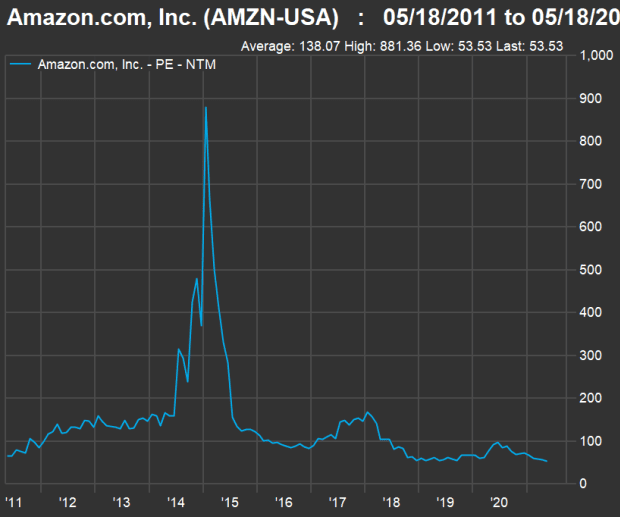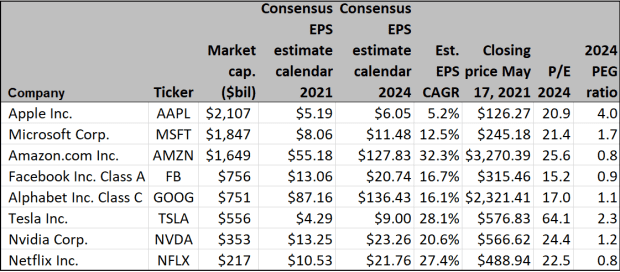We’ve heard for years Amazon is an expensive stock. But that’s no longer true. Yes, if you just look at its price-to-earnings ratio, it seems high.
But if you use a different metric that measures growth longer-term, Amazon is actually cheap compared to peers. Check out this commentary and these charts that reveal the story.
Amazon.com, despite its high valuation by the traditional price-to-earnings ratio, is a bargain stock for long-term investors. And this may be a perfect time to consider making a purchase.
The forward price-to-earnings (P/E) ratio is the current share price divided by the consensus earnings-per-share estimate for the next 12 rolling months.
Here’s a look at a 10-year forward P/E chart based on consensus estimates among analysts polled by FactSet:

The current forward P/E of 53.5 for Amazon.com is just above its low point for the past 10 years.
You might be saying that Amazon is expensive because its forward P/E is more than twice the S&P 500 Index’s 21.5. But the forward P/E doesn’t take Amazon’s incredible growth rate into account.
If we look back over the past five full years, Amazon’s earnings per share have increased at a compound annual growth rate (CAGR) of 101.8%.
That compares to an EPS CAGR of only 3.4% for the S&P 500.
Amazon is on sale
A company’s PEG ratio is its price-to-earnings-to-growth ratio. It is calculated by dividing a P/E ratio by earnings-per-share CAGR.
Here are 2024 PEG ratios for the eight largest tech companies by market capitalization for which consensus 2024 EPS estimates are available.

Apple has the highest 2024 PEG ratio among the listed companies, because it has the lowest expected EPS CAGR by far.
Amazon is tied with Netflix for the lowest 2024 PEG ratio of 0.8.
But Amazon shines even brighter with the highest expected EPS CAGR from 2021 through 2024.
Think long-term
This is obviously a very long-term way of looking at stock valuations. But that is appropriate, as stock investments (not trades) tend to work out best over longer periods.
It’s easy to say “Amazon’s stock has done nothing for six months,” and it is true — the shares were up only 4.3% for the six months through May 17. But they were up 30% over the preceding six months. And they are up 15-fold for 10 years.
From day to day or month to month, you cannot predict how a stock will perform as an investment.
But if a company continues to grow at a rapid pace as you hold the shares for many years, you have a good shot at making some money.
Related stories: Large-Cap Growth Companies’ Future Bright But They Don’t Need Shades

